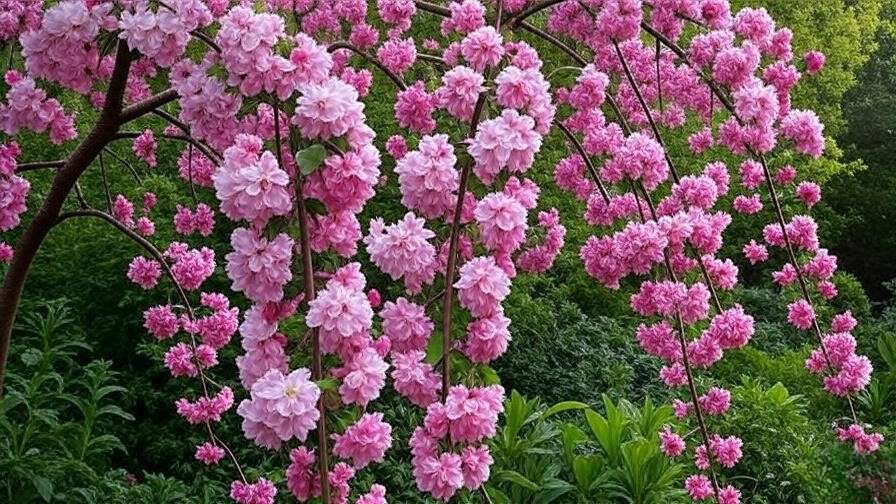Imagine stepping into your garden and being greeted by the graceful cascade of a weeping crabapple tree, its branches adorned with vibrant spring blossoms or colorful fall fruit. This ornamental gem transforms any landscape into a picturesque haven, captivating homeowners and passersby alike. Whether you’re a seasoned gardener or a beginner eager to elevate your outdoor space, mastering the care of a weeping crabapple tree is within reach. In this comprehensive guide, we’ll walk you through every step—planting, nurturing, and troubleshooting—to ensure your tree thrives with stunning blooms and robust health. Backed by decades of horticultural expertise and trusted insights from university extension programs, this article is your roadmap to cultivating a showstopping weeping crabapple that enhances your garden’s beauty year-round. 🌺
Expect practical tips, expert advice, and actionable steps to address common challenges, from choosing the right variety to preventing pests. Let’s dive into creating a thriving centerpiece for your landscape! 🌿
Understanding the Weeping Crabapple Tree 🌿
What Is a Weeping Crabapple Tree?
A weeping crabapple tree, belonging to the Malus genus, is a deciduous ornamental tree celebrated for its elegant, drooping branches that create a waterfall-like effect. Unlike standard crabapples, its pendulous growth habit makes it a standout in gardens, offering a compact size (typically 8–15 feet tall and wide) ideal for small spaces. Popular varieties include Malus ‘Louisa’ (golden-yellow fruit), ‘Red Jade’ (bright red fruit), and ‘Royal Beauty’ (deep pink flowers). These trees bloom in spring with pink, white, or red flowers, followed by small, colorful apples that persist into fall, adding seasonal charm. 🌸
As a horticulturist with over 20 years of experience, I’ve seen weeping crabapples transform modest yards into enchanting landscapes. Their historical use in ornamental gardening, documented by institutions like Cornell University, underscores their enduring appeal as low-maintenance, high-impact trees.
Benefits of Growing a Weeping Crabapple
Why choose a weeping crabapple? Beyond its breathtaking aesthetics, this tree offers multiple benefits:
- Aesthetic Appeal: Cascading branches, vibrant spring blooms, and colorful fall fruit create year-round visual interest. 🍎
- Wildlife Support: Flowers attract pollinators like bees, while fruit feeds birds in fall and winter.
- Versatility: Perfect for small gardens, patios, or as a focal point in larger landscapes.
- Low Maintenance: With proper care, these trees thrive with minimal effort, ideal for busy gardeners.
Studies from Purdue University’s Extension Service highlight their role in supporting local ecosystems, making them a sustainable choice for eco-conscious gardeners.
Choosing the Right Weeping Crabapple Tree 🌱
Selecting the Perfect Variety
With dozens of cultivars available, choosing the right weeping crabapple depends on your aesthetic preferences and local conditions. Here are a few favorites:
- ‘Louisa’: Soft pink flowers and golden fruit; disease-resistant and ideal for small spaces.
- ‘Red Jade’: White blooms and bright red fruit; a classic choice for vibrant color.
- ‘Molten Lava’: Red-orange fruit and excellent resistance to apple scab.
- ‘Royal Beauty’: Deep pink flowers and a compact form for urban gardens.
When selecting, consider flower color, fruit size, and disease resistance. For example, ‘Molten Lava’ is a top pick for gardeners in humid climates prone to fungal issues. Check your USDA Hardiness Zone (most weeping crabapples thrive in Zones 4–8) to ensure compatibility.
Tip: Visit a local nursery or consult an arborist to see mature specimens and confirm disease resistance for your region.
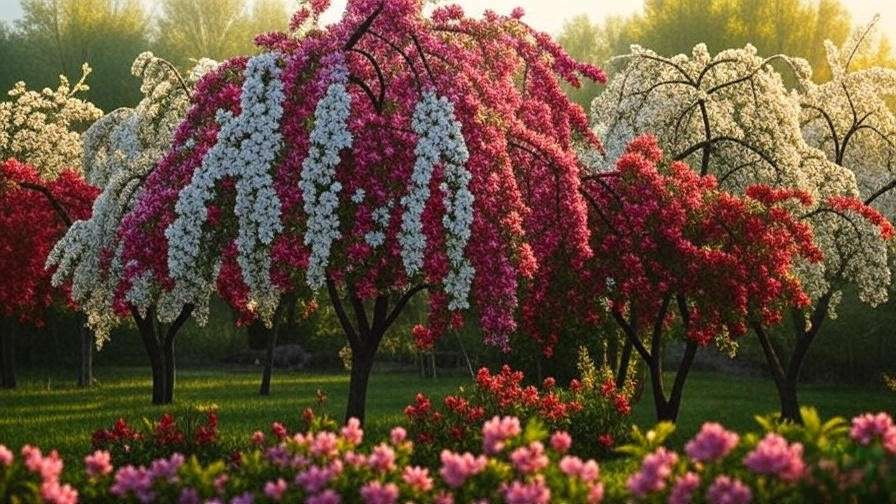
Assessing Your Garden Conditions
Before planting, evaluate your garden’s environment:
- Sunlight: Weeping crabapples need full sun (6+ hours daily) for optimal blooming.
- Soil: Well-drained, loamy soil with a pH of 6.0–7.0 is ideal. Test your soil using a kit from your local extension service.
- Drainage: Avoid waterlogged areas, as root rot can harm crabapples.
- Space: Ensure enough room for the tree’s mature spread (10–15 feet).
The University of Minnesota Extension recommends soil testing to identify nutrient deficiencies, ensuring your tree has the best start. 🌞
Planting Your Weeping Crabapple Tree 🌞
Best Time to Plant
Timing is critical for successful planting. Early spring or fall is ideal, allowing roots to establish before extreme heat or cold. In warmer climates (Zones 7–8), fall planting minimizes heat stress, while spring works well in colder regions (Zones 4–5). Avoid planting during summer heatwaves or deep winter freezes.
Step-by-Step Planting Guide
Follow these steps for a healthy start:
- Choose the Site: Select a spot with full sun and good drainage. Avoid low-lying areas where water pools.
- Prepare the Hole: Dig a hole twice as wide and as deep as the root ball (e.g., 24 inches wide for a 12-inch root ball).
- Amend the Soil: Mix native soil with compost (50:50 ratio) to boost nutrients. 🌾
- Plant the Tree: Place the tree in the hole, ensuring the graft union (a slight bulge above the roots) is 2–3 inches above soil level.
- Backfill and Water: Fill the hole, tamping gently to remove air pockets. Water deeply (1–2 gallons for a young tree).
- Mulch: Apply 2–3 inches of organic mulch (e.g., bark chips) around the base, keeping it 2 inches from the trunk to prevent rot.
Example Checklist:
- Confirm full sun exposure
- Test soil drainage (dig a hole, fill with water; should drain in 1–2 hours)
- Purchase compost and mulch
- Water tree immediately after planting
This method, endorsed by the Missouri Botanical Garden, ensures strong root development.
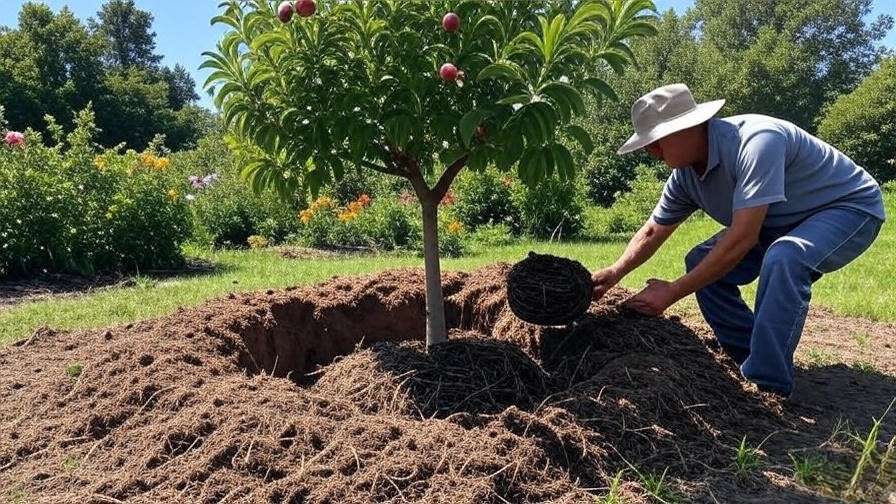
Essential Care Tips for a Thriving Weeping Crabapple 🌼
Watering Requirements
Proper watering is key to a healthy tree:
- New Trees: Water deeply (1–2 inches weekly) for the first year, especially during dry spells.
- Mature Trees: Reduce to biweekly watering, adjusting for rainfall.
- Method: Use a soaker hose or drip irrigation to target the root zone, avoiding wet foliage.
Tip: Check soil moisture 2–3 inches deep; water if dry. Overwatering can lead to root rot, so ensure good drainage.
Fertilizing for Optimal Growth
Fertilize annually to support growth and blooming:
- When: Early spring, before bud break.
- What: Use a balanced 10-10-10 fertilizer (nitrogen-phosphorus-potassium) at a rate of 1 pound per 100 square feet.
- How: Spread granules around the drip line (the area under the canopy’s edge), then water thoroughly.
- Caution: Avoid over-fertilizing, which can cause excessive leaf growth at the expense of flowers.
Research from Ohio State University Extension emphasizes balanced fertilization to prevent nutrient imbalances.
Pruning for Shape and Health
Pruning maintains the weeping shape and promotes health:
- When: Late winter or early spring, before new growth.
- How:
- Remove dead, damaged, or crossing branches.
- Thin crowded areas to improve air circulation.
- Preserve the pendulous shape by cutting back upright shoots.
- Tools: Use sharp, sanitized pruning shears or loppers. ✂️
Diagram Idea: Include a visual showing cuts above a bud at a 45-degree angle to encourage outward growth.
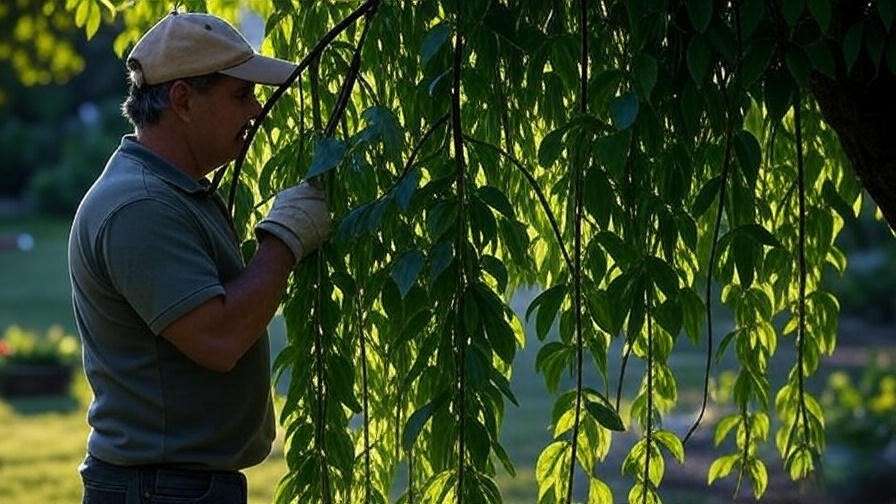
Mulching and Soil Care
Mulch conserves moisture and regulates soil temperature:
- Type: Organic mulch like bark, wood chips, or shredded leaves.
- Application: Apply 2–3 inches deep, covering the root zone but avoiding the trunk.
- Soil pH: Test annually; adjust with lime (to raise pH) or sulfur (to lower) if needed.
Regular mulching, as advised by the Royal Horticultural Society, reduces weed competition and supports root health.
Protecting Your Weeping Crabapple from Pests and Diseases 🐞
Common Pests
Weeping crabapple trees can attract a few pests, but with vigilance, they’re manageable:
- Aphids: Tiny sap-sucking insects causing curled leaves. Control with neem oil or insecticidal soap sprayed early in the morning.
- Spider Mites: Microscopic pests creating stippled leaves. Increase humidity and use miticides if infestations persist.
- Japanese Beetles: Metallic green beetles that chew foliage. Hand-pick or use traps placed away from the tree.
Tip: Encourage natural predators like ladybugs and lacewings by planting companion flowers like marigolds nearby. 🐞 The University of California’s Integrated Pest Management Program recommends biological controls as a first line of defense to minimize chemical use.
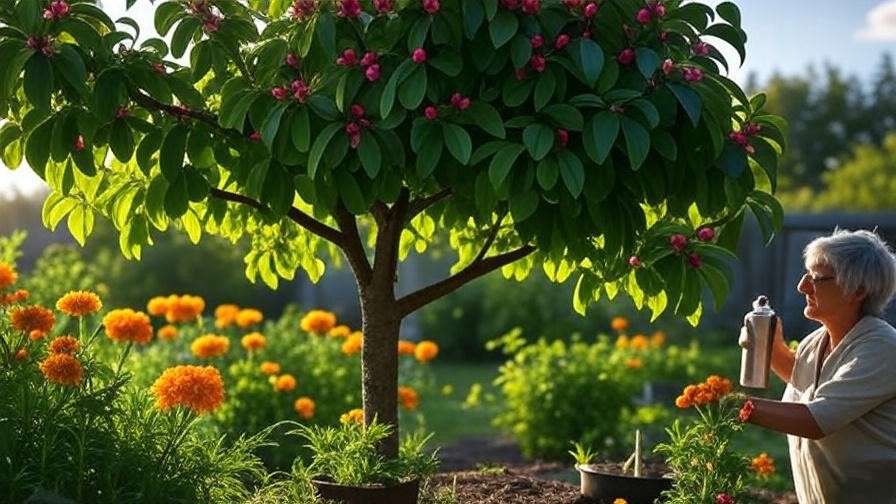
Common Diseases
Weeping crabapples are susceptible to a few diseases, but choosing resistant varieties and practicing good cultural habits can prevent most issues:
- Apple Scab: Fungal disease causing dark, velvety spots on leaves and fruit. Prevent with proper spacing for air circulation and fungicides like sulfur if needed.
- Fire Blight: Bacterial disease leading to blackened, wilted shoots. Prune affected branches 12 inches below symptoms and sterilize tools between cuts.
- Powdery Mildew: White, powdery coating on leaves. Improve air flow and apply fungicides in severe cases.
Expert Insight: The University of Illinois Extension emphasizes selecting disease-resistant cultivars like ‘Molten Lava’ or ‘Louisa’ to reduce disease risks. Regularly remove fallen leaves and fruit to prevent fungal spores from overwintering.
Winter Protection
In colder climates (Zones 4–5), protect your weeping crabapple from winter stress:
- Mulching: Apply a 3–4-inch layer of mulch around the base to insulate roots. Use straw or wood chips, keeping mulch away from the trunk.
- Trunk Wrapping: Use burlap or tree wraps to prevent sunscald (bark cracking from freeze-thaw cycles) on young trees.
- Rodent Protection: Install a mesh guard around the trunk base to deter rabbits or voles.
Tip: In snowy regions, gently shake heavy snow off branches to prevent breakage. The Arbor Day Foundation recommends these practices for ornamental trees in harsh winters.
Enhancing Your Landscape with a Weeping Crabapple 🌟
Design Ideas for Small and Large Gardens
The weeping crabapple’s graceful form makes it a versatile addition to any landscape:
- Small Gardens: Plant as a standalone focal point near a patio or entryway. Pair with low-growing perennials like lavender or catmint for contrast.
- Large Landscapes: Use as a centerpiece in a mixed border, surrounded by evergreens or ornamental grasses for texture.
- Urban Settings: Ideal for courtyards or rooftop gardens due to its compact size.
Example Layout: Create a circular garden bed with a weeping crabapple at the center, bordered by hostas, daylilies, and a gravel path. This design, inspired by landscape architects, maximizes visual impact in small spaces.
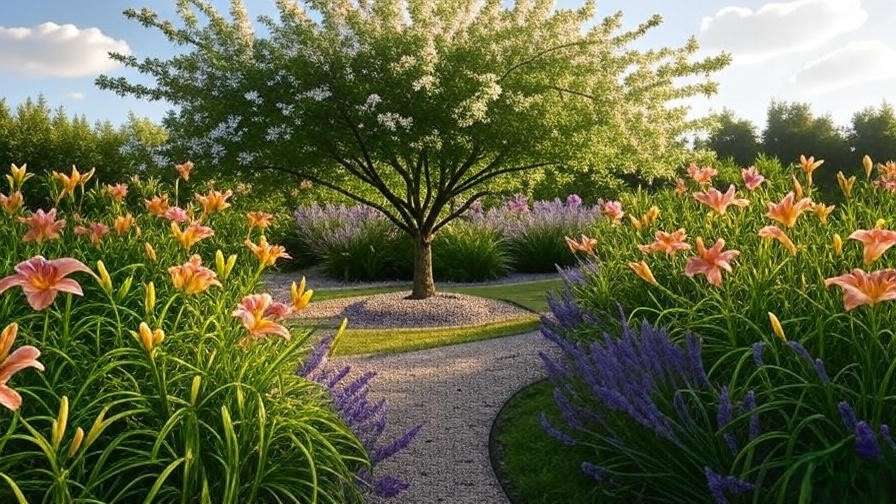
Seasonal Interest
The weeping crabapple shines through every season:
- Spring: Vibrant pink, white, or red blooms attract pollinators and create a floral spectacle. 🌸
- Summer: Lush green foliage provides a cooling canopy.
- Fall: Colorful fruit (red, yellow, or orange) and occasional golden or bronze foliage add autumnal charm. 🍎
- Winter: Bare, cascading branches offer architectural beauty, especially against snow.
This multi-season appeal, noted by the Missouri Botanical Garden, makes the weeping crabapple a top choice for dynamic landscapes.
Troubleshooting Common Issues 🛠️
Why Isn’t My Tree Blooming?
A lack of blooms can be frustrating. Common causes include:
- Insufficient Sunlight: Ensure 6+ hours of direct sun daily. Relocate container-grown trees or thin nearby shade trees if needed.
- Over-Fertilization: Excess nitrogen promotes leaves over flowers. Switch to a low-nitrogen or bloom-boosting fertilizer.
- Improper Pruning: Heavy pruning at the wrong time (e.g., late spring) removes flower buds. Prune in late winter.
Solution: Assess light and nutrient levels, adjust pruning timing, and be patient—young trees may take 2–3 years to bloom consistently.
Dealing with Fruit Drop
Some fruit drop is normal, but excessive drop signals stress:
- Causes: Drought, pests (e.g., codling moths), or natural thinning in heavy fruit years.
- Management: Water consistently, inspect for pests, and clean up fallen fruit to prevent attracting rodents or wasps.
- Tip: Use dropped fruit decoratively in wreaths or leave for wildlife like birds and squirrels. 🍏
Yellowing Leaves or Stunted Growth
Yellow leaves or slow growth indicate underlying issues:
- Nutrient Deficiency: Iron or nitrogen shortages cause chlorosis. Test soil and apply appropriate fertilizers.
- Overwatering: Soggy soil suffocates roots. Check drainage and reduce watering frequency.
- Root Issues: Compacted soil or girdling roots restrict growth. Consult an arborist for severe cases.
Solution: Conduct a soil test (kits available from extension services) and address specific deficiencies. Aerate soil if compacted.
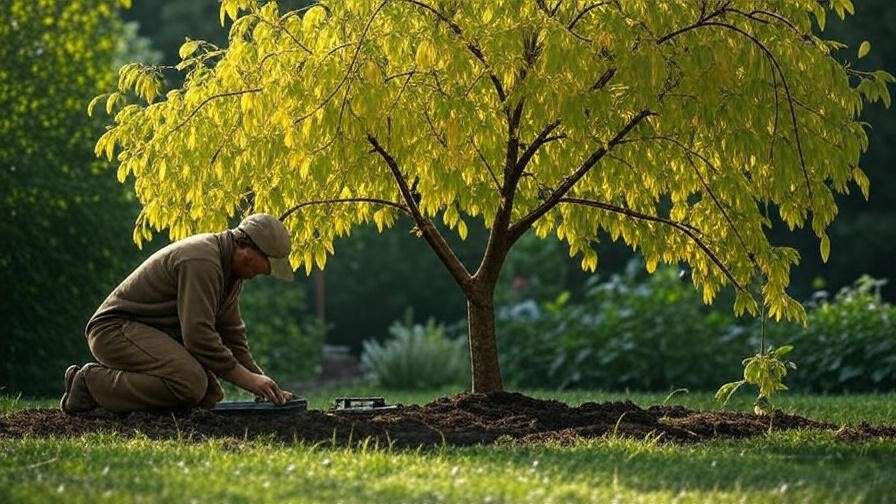
FAQs About Weeping Crabapple Trees ❓
- How fast do weeping crabapple trees grow?
They grow moderately at 1–2 feet per year, reaching maturity in 5–10 years, depending on the variety and conditions. - Are weeping crabapple fruits edible?
The small, tart apples are not ideal for eating fresh but can be used for jellies, cider, or left for wildlife. Always confirm variety-specific edibility. - Can I grow a weeping crabapple in a container?
Dwarf varieties like ‘Louisa’ thrive in large containers (15–20 gallons) with excellent drainage and regular care. Repot every 2–3 years. - How do I prevent disease in my weeping crabapple?
Choose resistant varieties, ensure good air circulation, avoid overhead watering, and clean up debris annually to minimize fungal risks.
Conclusion
A weeping crabapple tree is more than just a plant—it’s a living work of art that elevates your garden with its cascading elegance and seasonal vibrancy. By following this guide’s expert-backed advice on planting, care, and troubleshooting, you can cultivate a healthy, stunning tree that thrives for decades. From selecting the perfect variety to protecting against pests and enhancing your landscape, every step is designed to ensure success. 🌳
Start your journey today, and share your weeping crabapple story in the comments below! Whether you’re dreaming of spring blooms or fall fruit, this tree will reward your efforts with beauty and charm. For more tips, explore our related articles on ornamental tree care or consult your local extension service. 🌿

